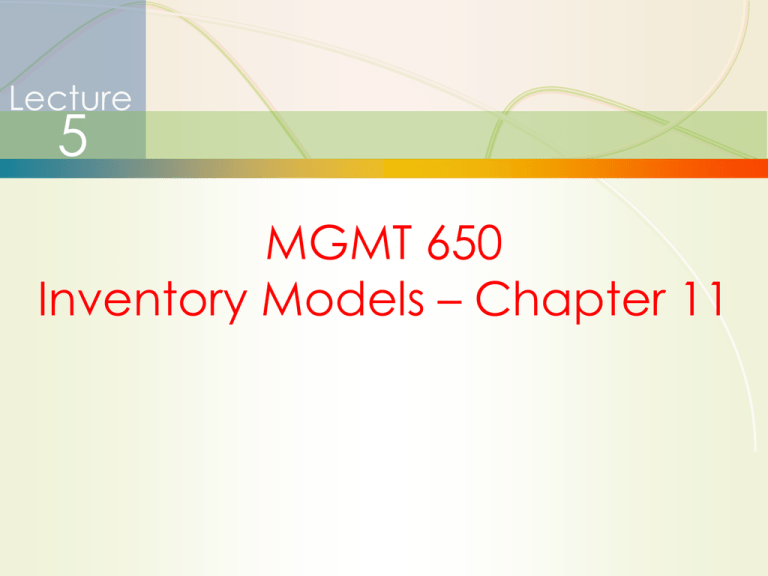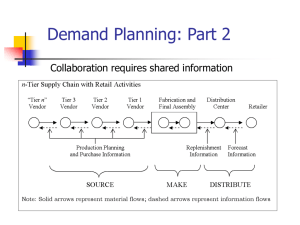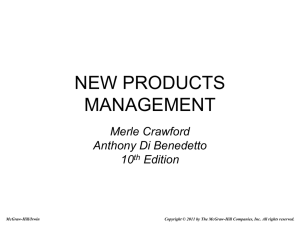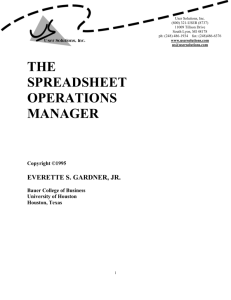Document
advertisement

Lecture 5 MGMT 650 Inventory Models – Chapter 11 1 Announcements HW #3 solutions and grades posted in BB HW #3 average = 134.4 (out of 150) Final exam next week Open book, open notes…. Final preparation guide posted in BB Proposed class structure for next week Lecture – 6:00 – 7:50 Class evaluations – 7:50 – 8:00 Break – 8:00 – 8:30 Final – 8:30 – 9:45 2 Inventory Management – In-class Example Number 2 pencils at the campus book-store are sold at a fairly steady rate of 60 per week. It cost the bookstore $12 to initiate an order to its supplier and holding costs are $0.005 per pencil per year. Determine The optimal number of pencils for the bookstore to purchase to minimize total annual inventory cost, Number of orders per year, The length of each order cycle, Annual holding cost, Annual ordering cost, and Total annual inventory cost. If the order lead time is 4 months, determine the reorder point. Illustrate the inventory profile graphically. What additional cost would the book-store incur if it orders in batches of 1000? 3 Management Scientist Solutions 4 Management Scientist Solutions Chapter 11 Problem #4 EOQ (Time between placing 2 consecutive orders - in days) 5 EOQ with Quantity Discounts The EOQ with quantity discounts model is applicable where a supplier offers a lower purchase cost when an item is ordered in larger quantities. This model's variable costs are annual holding, Ordering cost, and purchase costs. For the optimal order quantity, the annual holding and ordering costs are not necessarily equal. 6 EOQ with Quantity Discounts Assumptions Demand occurs at a constant rate of D items/year. Ordering Cost is $Co per order. Holding Cost is $Ch = $CiI per item in inventory per year Purchase Cost (C) note holding cost is based on the cost of the item, Ci $C1 per item if quantity ordered is between 0 and x $C2 if order quantity is between x1 and x2 , etc. Lead time is constant 7 EOQ with Quantity Discounts Formulae Optimal order quantity: the procedure for determining Q * will be demonstrated Number of orders per year: D/Q * Time between orders (cycle time): Q */D years Total annual cost: (formula 11.28 of book) Q* D TC Ch C0 D.C * 2 Q (holding + ordering + purchase) 8 Example – EOQ with Quantity Discount Walgreens carries Fuji 400X instant print film The film normally costs Walgreens $3.20 per roll Walgreens sells each roll for $5.25 Walgreens's average sales are 21 rolls per week Walgreens’s annual inventory holding cost rate is 25% It costs Walgreens $20 to place an order with Fujifilm, USA Fujifilm offers the following discount scheme to Walgreens 7% discount on orders of 400 rolls or more 10% discount for 900 rolls or more, and 15% discount for 2000 rolls or more Determine Walgreen’s optimal order quantity 9 Management Scientist Solutions 10 Economic Production Quantity (EPQ) The economic production quantity model is a variant of basic EOQ model Production done in batches or lots A replenishment order is not received in one lump sum unlike basic EOQ model Inventory is replenished gradually as the order is produced This model's variable costs are hence requires the production rate to be greater than the demand rate annual holding cost, and annual set-up cost (equivalent to ordering cost). For the optimal lot size, annual holding and set-up costs are equal. 11 EPQ = EOQ with Incremental Inventory Replenishment 12 EPQ Model Assumptions Demand occurs at a constant rate of D items per year. Production rate is P items per year (and P > D ). Set-up cost: $Co per run. Holding cost: $Ch per item in inventory per year. Purchase cost per unit is constant (no quantity discount). Set-up time (lead time) is constant. Planned shortages are not permitted. 13 EPQ Model Formulae Optimal production lot-size (formula 11.16 of book) Q*= 2DCo /[(1-D/P )Ch] Number of production runs per year: D/Q * Time between set-ups (cycle time): Q */D years Total annual cost (formula 11.14 of book) [(1/2)(1-D/P )Q *Ch] + [DCo/Q *] (holding + ordering) 14 Example: Non-Slip Tile Co. Non-Slip Tile Company (NST) has been using production runs of 100,000 tiles, 10 times per year to meet the demand of 1,000,000 tile annually. The set-up cost is $5,000 per run Holding cost is estimated at 10% of the manufacturing cost of $1 per tile. The production capacity of the machine is 500,000 tiles per month. The factor is open 365 days per year. Determine Optimal production lot size Annual holding and setup costs Number of setups per year Loss/profit that NST is incurring annually by using their present production schedule 15 Management Scientist Solutions Optimal TC = $28,868 Current TC = .04167(100,000) + 5,000,000,000/100,000 = $54,167 LOSS = 54,167 - 28,868 = $25,299 16 Lecture 5 Forecasting Chapter 16 17 Forecasting - Topics Quantitative Approaches to Forecasting The Components of a Time Series Measures of Forecast Accuracy Using Smoothing Methods in Forecasting Using Trend Projection in Forecasting 18 Time Series Forecasts Trend - long-term movement in data Seasonality - short-term regular variations in data Cycle – wavelike variations of more than one year’s duration Irregular variations - caused by unusual circumstances Random variations - caused by chance 19 Forecast Variations Irregular variatio n Trend Cycles 90 89 88 Seasonal variations 20 Smoothing Methods In cases in which the time series is fairly stable and has no significant trend, seasonal, or cyclical effects, one can use smoothing methods to average out the irregular components of the time series. Four common smoothing methods are: Moving averages Weighted moving averages Exponential smoothing 21 Example of Moving Average Sales of gasoline for the past 12 weeks at your local Chevron (in ‘000 gallons). If the dealer uses a 3period moving average to forecast sales, what is the forecast for Week 13? Past Sales Week 1 2 3 4 5 6 Sales 17 21 19 23 18 16 Week 7 8 9 10 11 12 Sales 20 18 22 20 15 22 22 Management Scientist Solutions MA(3) for period 4 = (17+21+19)/3 = 19 Forecast error for period 3 = Actual – Forecast = 23 – 19 = 4 23 MA(5) versus MA(3) Actual 1 2 3 4 5 6 7 8 9 10 11 12 MA(3) 17 21 19 23 18 16 20 18 22 20 15 22 MA(5) MA Forecast Graph 19 21 20 19 18 18 20 20 19 19.6 19.4 19.2 19 18.8 19.2 19 Actual/MA Forecast sale values Week 25 20 Actual 15 MA(3) 10 MA(5) 5 0 1 2 3 4 5 6 7 8 9 10 11 12 Week 24 Exponential Smoothing • Premise - The most recent observations might have the highest predictive value. Therefore, we should give more weight to the more recent time periods when forecasting. Ft+1 = Ft + (At - Ft) 25 Linear Trend Equation Suitable for time series data that exhibit a long term linear trend Ft Ft = a + bt a 0 1 2 Ft = Forecast for period t t = Specified number of time periods a = Value of Ft at t = 0 b = Slope of the line 3 4 5 t 26 Linear Trend Example Linear trend equation F11 = 20.4 + 1.1(11) = 32.5 Sale increases every time period @ 1.1 units 27 Actual vs Forecast Actual/Forecasted sales Linear Trend Example 35 30 25 20 Actual 15 Forecast 10 5 0 1 2 3 4 5 6 7 8 9 10 Week F(t) = 20.4 + 1.1t 28 Measure of Forecast Accuracy MSE = Mean Squared Error Week # Actual (A) Forecast(F) Error =E =A-F E(squared) 1 21.6 21.5 0.1 0.01 2 22.9 22.6 0.3 0.09 3 25.5 23.7 1.8 3.24 4 21.9 24.8 -2.9 8.41 5 23.9 25.9 -2 4 6 27.5 27 0.5 0.25 7 31.5 28.1 3.4 11.56 8 29.7 29.2 0.5 0.25 9 28.6 30.3 -1.7 2.89 10 31.4 31.4 0 0 Sum of E(squared) 30.7 MSE= 3.07 29 Forecasting with Trends and Seasonal Components – An Example Business at Terry's Tie Shop can be viewed as falling into three distinct seasons: (1) Christmas (November-December); (2) Father's Day (late May - mid-June); and (3) all other times. Average weekly sales ($) during each of the three seasons during the past four years are known and given below. Determine a forecast for the average weekly sales in year 5 for each of the three seasons. Year Season 1 2 3 4 1 1856 1995 2241 2280 2 2012 2168 2306 2408 3 985 1072 1105 1120 30 Management Scientist Solutions 31 Interpretation of Seasonal Indices Seasonal index for season 2 (Father’s Day) = 1.236 Means that the sale value of ties during season 2 is 23.6% higher than the average sale value over the year Seasonal index for season 3 (all other times) = 0.586 Means that the sale value of ties during season 3 is 41.4% lower than the average sale value over the year 32 Lecture 5 Decision Analysis Chapter 14 33 Decision Environments Certainty - Environment in which relevant parameters have known values Risk - Environment in which certain future events have probabilistic outcomes Uncertainty - Environment in which it is impossible to assess the likelihood of various future events 34 Decision Making under Uncertainty Maximin - Choose the alternative with the best of the worst possible payoffs Maximax - Choose the alternative with the best possible payoff 35 Payoff Table: An Example Possible Future Demand Small facility Medium facility Large facility Low Moderate High $10 $10 $10 7 12 12 -4 2 16 Values represent payoffs (profits) 36 Maximax Solution Note: choose the “minimize the payoff” option if the numbers in the previous slide represent costs 37 Maximin Solution 38 Minimax Regret Solution 39 Decision Making Under Risk - Decision Trees Payoff 1 Decision Point Chance Event Payoff 2 2 Payoff 3 1 B Payoff 4 2 Payoff 5 Payoff 6 40 Decision Making with Probabilities Expected Value Approach Useful if probabilistic information regarding the states of nature is available Expected return for each decision is calculated by summing the products of the payoff under each state of nature and the probability of the respective state of nature occurring Decision yielding the best expected return is chosen. 41 Example: Burger Prince Burger Prince Restaurant is considering opening a new restaurant on Main Street. It has three different models, each with a different seating capacity. Burger Prince estimates that the average number of customers per hour will be 80, 100, or 120 with a probability of 0.4, 0.2, and 0.4 respectively The payoff (profit) table for the three models is as follows. • s1 = 80 s2 = 100 s3 = 120 Model A $10,000 $15,000 $14,000 Model B $ 8,000 $18,000 $12,000 Model C $ 6,000 $16,000 $21,000 Choose the alternative that maximizes expected payoff 42 Decision Tree d1 1 d2 d3 2 3 4 s1 s2 s3 .4 .2 .4 s1 .4 s2 s3 .2 s1 s2 s3 .4 .4 .2 .4 Payoffs 10,000 15,000 14,000 8,000 18,000 12,000 6,000 16,000 21,000 43 Management Scientist Solutions 44







